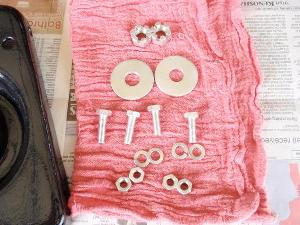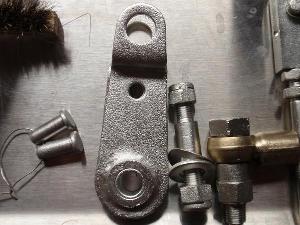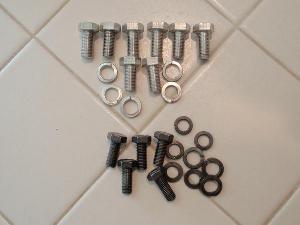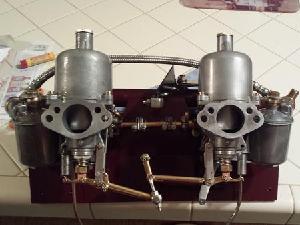The MGA With An Attitude
ZINC PLATING Small Parts At Home-- RT-110
This article is compliments of Ron Bissland in Kenosha, WI, USA.
 I have been using Eastwoods Tin-Zinc replating kit for over a year [now April 2015]. I am doing a frame off restore on a 1956 MGA that was bought by my uncle in March 1956 while in England at a US air base. He crashed his fighter jet two weeks after he got the car. The car was given to my dad who was a Navigator in a B29. Now I have it and I made a promise to my self that the car would be put back to the way if rolled off the showroom floor. So Everything will be original where possible. In saying that, now you know why I plate everything by hand. Every nut, bolt, screw, washer and few other items have been replated. It is not cheap to do and it is very time consuming, but it sure looks good. I have been using Eastwoods Tin-Zinc replating kit for over a year [now April 2015]. I am doing a frame off restore on a 1956 MGA that was bought by my uncle in March 1956 while in England at a US air base. He crashed his fighter jet two weeks after he got the car. The car was given to my dad who was a Navigator in a B29. Now I have it and I made a promise to my self that the car would be put back to the way if rolled off the showroom floor. So Everything will be original where possible. In saying that, now you know why I plate everything by hand. Every nut, bolt, screw, washer and few other items have been replated. It is not cheap to do and it is very time consuming, but it sure looks good.
 I have spent lots of time trying to figure out the beat way to plate items and this is now my current process. The best plating is to make sure it is 100% rust free, and grease or oil free. So here is the process I use. I have spent lots of time trying to figure out the beat way to plate items and this is now my current process. The best plating is to make sure it is 100% rust free, and grease or oil free. So here is the process I use.
 Everything is degreased, then glass beaded. There are times I then put into a tumbler if i want to remove rough edges. After blasting I put into fast etch to make sure there is no flash rust and to ensure there is no rust on the part anywhere. When done I move to jar of thinner to remove oils (wearing nitrate gloves). Then I have a large assortment of stainless steel wire wheels and brushes. The Wire wheels are used in a Dremel. I have two Dremels with two different styles of wire wheels. I then have a cordless drill to use with the wire brushes for cleaning holes. The parts are wire brushed and then added to the plating system. I have about 4 different pieces of Romex cable about 5 inches long. I strip the wire from the Romex and strip the insulation only enough to clip an alligator on one end and then different hooks and angles at the other based on what is being plated. Based on the item I let it stay in the solution for 3-5 minutes. Then remove and dip it in a bowl of hot water to remove the acid. Remove from hot water and you will see the item has a light gray coating. I then remove this coating with the SOFT wire wheel in the Dremel or a small hand stainless steel wire brush. While I am doing this another item is being plated. After the items have one coating, I do them again. I keep doing them until I get the desired finish. When done they get bagged and tagged. Do not leave in the solution too long or the plating gets glumpy. Everything I do gets min two coats, some get 3 or 4. Everything is degreased, then glass beaded. There are times I then put into a tumbler if i want to remove rough edges. After blasting I put into fast etch to make sure there is no flash rust and to ensure there is no rust on the part anywhere. When done I move to jar of thinner to remove oils (wearing nitrate gloves). Then I have a large assortment of stainless steel wire wheels and brushes. The Wire wheels are used in a Dremel. I have two Dremels with two different styles of wire wheels. I then have a cordless drill to use with the wire brushes for cleaning holes. The parts are wire brushed and then added to the plating system. I have about 4 different pieces of Romex cable about 5 inches long. I strip the wire from the Romex and strip the insulation only enough to clip an alligator on one end and then different hooks and angles at the other based on what is being plated. Based on the item I let it stay in the solution for 3-5 minutes. Then remove and dip it in a bowl of hot water to remove the acid. Remove from hot water and you will see the item has a light gray coating. I then remove this coating with the SOFT wire wheel in the Dremel or a small hand stainless steel wire brush. While I am doing this another item is being plated. After the items have one coating, I do them again. I keep doing them until I get the desired finish. When done they get bagged and tagged. Do not leave in the solution too long or the plating gets glumpy. Everything I do gets min two coats, some get 3 or 4.
 Another thing is to make sure the anode rod is keep clean. It will develop a black film on it, but that will wash off with water. The cleaner the rod, the better and faster the plating. My battery source is two D rechargeable batteries that I keep charging wire on them all the time from a old charge that puts out 3 volts. Another thing is to make sure the anode rod is keep clean. It will develop a black film on it, but that will wash off with water. The cleaner the rod, the better and faster the plating. My battery source is two D rechargeable batteries that I keep charging wire on them all the time from a old charge that puts out 3 volts.
 Some of the bolts after reinstalled on the car are coated with a CLEAR protective coating. Yes it takes time, but I have the ability to plate most anything at any given time. I just finished my carbs, horns and wiper motor, and all the items were replated, except the main housings. I am not promoting Eastwood. It just so happens that is the unit i am using. What ever unit or process you use, the bottom line is it is nice to be able to do your own parts. I have used the system on other items not related to the Restore project. Some of the bolts after reinstalled on the car are coated with a CLEAR protective coating. Yes it takes time, but I have the ability to plate most anything at any given time. I just finished my carbs, horns and wiper motor, and all the items were replated, except the main housings. I am not promoting Eastwood. It just so happens that is the unit i am using. What ever unit or process you use, the bottom line is it is nice to be able to do your own parts. I have used the system on other items not related to the Restore project.
 Attached are some pics. -- Ron Bissland Attached are some pics. -- Ron Bissland




|